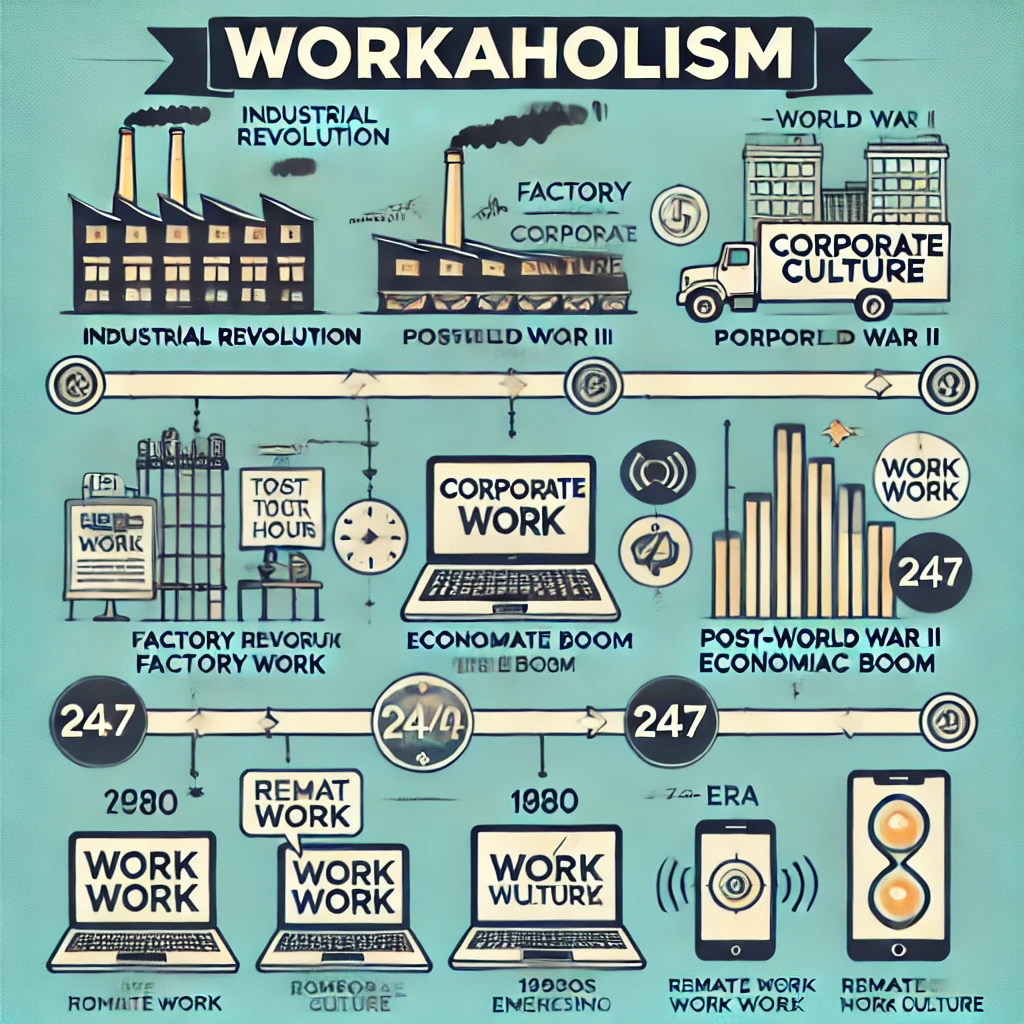The Rise of the Workaholic: How Capitalism Selected for Overwork and Is Shaping Society
In the relentless hustle of modern life, we often celebrate those who put in long hours, wear exhaustion as a badge of honor, and grind their way to the top. Whether it’s in the boardroom, the lab, or even in politics, the workaholic reigns supreme. But is this relentless pursuit of work shaping more than just our individual lives? Could it be that capitalism itself has selected for workaholics, pushing them to positions of power, and in doing so, shaping our entire society?
Workaholism: More than Just Dedication
Let’s be clear—working hard is different from being a workaholic. Workaholism is a compulsive drive to work, where boundaries blur and personal time dissolves into the never-ending demands of emails, meetings, and deadlines. It’s the feeling of guilt when you’re not working, even on weekends or vacations. This isn’t just dedication; it’s an obsession. And while this may seem like an individual struggle, it’s much more than that. It’s a phenomenon deeply embedded in the structure of modern capitalism.
Historically, work has always been tied to survival, but the industrial revolution transformed work into an identity. The rise of factory jobs and the 9-to-5 grind made work not just a way to live, but a way of life. In today’s hyperconnected world, technology keeps us tethered to our jobs 24/7, making it harder to disconnect.
Example: A friend of mine, working in a fast-paced startup, once mentioned how they regularly pulled 16-hour days, glorified by their peers as part of the “hustle culture.” But behind the scenes, the reality was different—burnout, strained relationships, and deteriorating mental health were common among the team. Yet, the workaholics continued to rise, applauded for their dedication.
Capitalism’s Selection Mechanism: The Rise of the Workaholic
Capitalism thrives on competition. In this system, those who work the hardest—or at least appear to—tend to reap the most rewards. The reward structure in many industries favors the workaholic. Promotions, raises, and status often go to those who demonstrate an “above and beyond” work ethic. Over time, this has led to an economic version of Darwinism, where workaholics are selected for, climbing higher in the social and corporate ladder.
Cultural narratives fuel this process. From the stories of Steve Jobs sleeping at the office to tales of Elon Musk working 100-hour weeks, society glorifies the workaholic as the ultimate success story. The message? Work harder, sleep less, and maybe, one day, you’ll be a billionaire.
Case Study: The Tech Industry
The tech startup world is a perfect example of how capitalism selects for workaholics. With funding often tied to short-term results, founders and employees are expected to sacrifice personal time for the growth of the company. As a result, burnout rates are sky-high, but those who survive are often propelled to positions of influence.
Impact on Society: A Workaholic World
Politics: The Overworked Leader
In politics, workaholism is rampant. Many high-profile leaders are known for their long hours and relentless work schedules. While this may seem admirable, the pressure to constantly “do more” can affect decision-making. Leaders may focus on short-term fixes rather than long-term solutions, simply because they are too overwhelmed by the immediate tasks on their plate.
Science: Publish or Perish
Academia is another domain where workaholism reigns supreme. The “publish or perish” mentality means scientists feel the pressure to constantly produce research, often at the cost of their personal well-being. Burnout among academics is rising, but the system rewards those who push themselves beyond the brink. The problem is, overwork doesn’t necessarily lead to more breakthroughs. In fact, it can stifle creativity and critical thinking, essential ingredients for innovation.
Psychiatry: The Paradox of Treating Workaholism
Interestingly, while psychiatry recognizes workaholism as a problem, society often doesn’t. It’s a paradox: Workaholism can lead to mental health issues like anxiety, depression, and burnout, but because it’s rewarded, many don’t seek help until it’s too late. The challenge for psychiatry is treating a behavior that’s simultaneously destructive and applauded by society. Also, an aspect that i find interesting here is the equivalent of the “History is written by winners” in the psychiatric prism. Who wrote the DMS-5 ? What if the answser was: “Workaholics” ? That would thus impply a pretty big bias in what is currently consisdered as normal mental health…
Education: Grooming Future Workaholics
The education system reflects the same issues, preparing the next generation for the grind. With increasing academic pressures, students are being trained to prioritize work over everything else, grooming them for future workaholism. This constant stress can have lasting effects on mental health and social development.
Societal Consequences: When Overwork Becomes the Norm
As workaholism becomes the norm, society pays the price. Burnout is rising, relationships are deteriorating, and we are losing the ability to balance work and personal life. Family structures are strained as workaholics spend more time at the office than at home. The very fabric of our social lives is shifting, and not for the better.
What’s more, this drive to work at all costs widens economic inequality. Those able to work longer hours (often the wealthier or more privileged) rise to the top, while others are left behind, unable to compete in a system that rewards overwork.
A Balanced Perspective
It’s important to recognize that hard work has its benefits. Dedication and ambition are important traits, and they drive progress in many fields. However, there is a limit to the benefits of work. Research shows that working beyond 50 hours a week doesn’t significantly increase productivity. In fact, it can lead to diminishing returns as fatigue and stress take over.
Example of Cultural Variation: In Scandinavian countries, where work-life balance is prioritized, productivity remains high despite shorter workweeks. This demonstrates that balance, not overwork, may be the key to long-term success.
Solutions: How Do We Stop the Workaholic Machine?
While it may be difficult to dismantle the systems that have selected for workaholics, change is possible. Policy interventions like work-hour regulations, corporate responsibility for employee well-being, and promoting work-life balance can help shift societal norms.
Companies must take the lead by fostering healthier work environments and rejecting the glorification of overwork. Encouraging flexibility, promoting mental health, and rewarding productivity rather than hours spent at a desk are small steps that can make a big difference.
At an individual level, managing work habits and prioritizing personal time are crucial for avoiding the trap of workaholism. As a society, we need to redefine success—not just as how much we can produce, but how we live our lives outside of work as well.
Conclusion: Reimagining Success Beyond Work
The world has been shaped by workaholics, especially in a capitalist system that rewards those willing to give everything to their jobs. But as burnout, mental health crises, and economic inequality rise, it’s time to ask ourselves: Is this really the world we want to live in?
By recognizing the societal cost of workaholism and striving for balance, we can begin to reshape our relationship with work—and perhaps even reshape society itself.
Potential References
- Workaholics Anonymous: The Power of Overworking in a 24/7 World
- “Workaholism and Mental Health: A Systematic Review” in Journal of Occupational Health Psychology
- “The Myth of Endless Productivity” from Harvard Business Review




